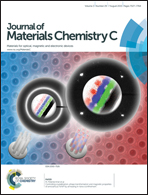Donor–acceptor–donor conjugated oligomers based on isoindigo and anthra[1,2-b]thieno[2,3-d]thiophene for organic thin-film transistors: the effect of the alkyl side chain length on semiconducting properties†
Abstract
Three donor–acceptor–donor (D–A–D) conjugated oligomers, i.e., 2ATT-IID-C8C10, 2ATT-IID-C6C8 and 2ATT-IID-C4C6, have been synthesized using anthra[1,2-b]thieno[2,3-d]thiophene (ATT) as an electron-donor unit and isoindigo (IID) as an electron-acceptor unit by combining the planar and rigid structure of fused aromatics and the strong intramolecular interaction of D–A conjugated molecules, and their semiconducting properties were studied via organic thin-film transistors (OTFTs). The alkyl chains, which are 2-octyldodecyl (C8C10), 2-hexyldecyl (C6C8) and 2-butyloctyl (C4C6), respectively, were employed in the IID unit in order to study the effect of alkyl bulkiness on the properties of the oligomers. All three oligomers adopted an edge-on alignment in thin films. Decreasing the bulkiness or length of the alkyls caused a noticeable improvement of the packing order of the oligomers, leading to a remarkably enhanced charge carrier mobility. 2ATT-IID-C8C10 could only form the film featured with one-dimensional order. Consequently, it exhibited the lowest OTFT mobility (<0.1 cm2 V−1 s−1). In contrast, both 2ATT-IID-C6C8 and 2ATT-IID-C4C6 adopted two-dimensional-ordered packing structures after thermal annealing with a π–π stacking distance of ∼3.6 Å, thereby exhibiting promising semiconducting properties. 2ATT-IID-C4C6 showed the best OTFT performance with a mobility of 0.72 cm2 V−1 s−1. This mobility is among the highest for the solution processible D–A conjugated oligomers to date.
![Graphical abstract: Donor–acceptor–donor conjugated oligomers based on isoindigo and anthra[1,2-b]thieno[2,3-d]thiophene for organic thin-film transistors: the effect of the alkyl side chain length on semiconducting properties](/en/Image/Get?imageInfo.ImageType=GA&imageInfo.ImageIdentifier.ManuscriptID=C5TC01461A&imageInfo.ImageIdentifier.Year=2015)

 Please wait while we load your content...
Please wait while we load your content...